In its most basic form, there are three ways a B2B SaaS company can make more money:
Sometimes SaaS companies are so focused on creating and improving the product, they neglect marketing it and improving the sales funnel. Companies without a marketing, PR, or growth team especially neglect it.
In terms of revenue, marketing is just as important as a great product. Thinking great products sell themselves couldn’t be farther from the truth so it’s important to allocate resources to optimizing your acquisition and onboarding processes and strategies.
Here are five ways you can increase your conversion rate and revenue that you can implement today.
1. Add Powerful Testimonials
Don’t underestimate how much a great testimonial can impact the conversion rate of your SaaS app. While incorporating testimonials may not be a revolutionary tactic, many companies add testimonials that don’t help conversion rates even if they do sound good.
Bad testimonials can sound corny, unrealistic, or too unbelievable; they can be emotionless, meaningless, and not specific enough. Here’s an example of a real B2B SaaS company using ineffective testimonials.

They all sound good, but they are so generic and so unspecific that these testimonials could be applied to virtually any SaaS app. And they’re probably fake.
Freshbooks currently has three powerful testimonials on their homepage:
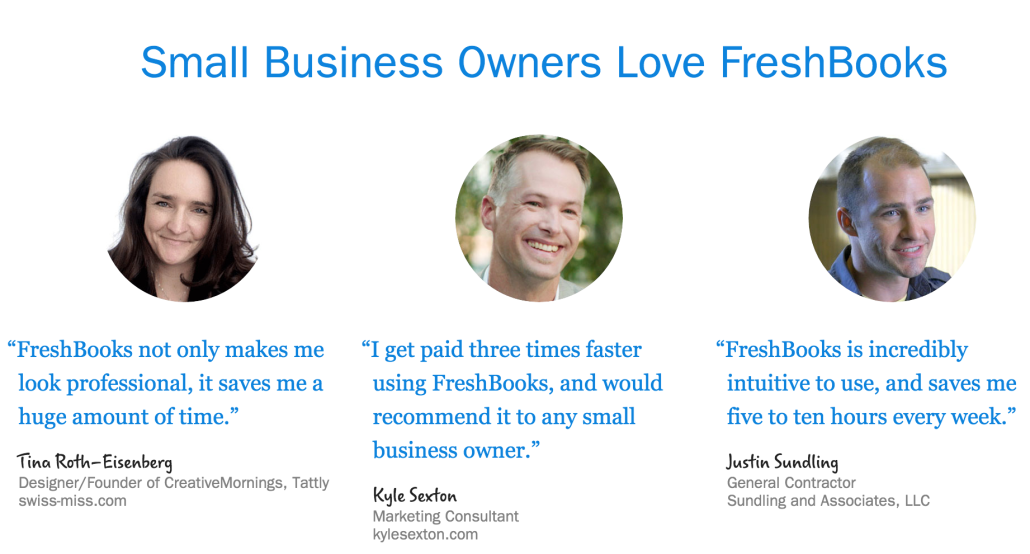
Why are these testimonials powerful?
Each one touches on a major pain point people come to Freshbooks to solve.
- “I want to look professional and be taken seriously when I send an invoice.”
- “I don’t want to have to wait 30 days to get paid.”
- “I don’t want to spend hours on the weekend making invoices when I have better things to do.”
Plus, each testimonial displays legitimacy with a photo, name, title, and industry. These people reflect major customer types and industries that Freshbooks serves allowing their prospective customers to put themselves in the shoes of the person who they match closest with. Once they see someone exactly like them using Freshbooks to solve their same issues, they are much more inclined to start a free trial.
The keys to a great testimonial:
- Reassures it solves a major pain point
- Includes details and is specific
- Made by a relevant customer type
- Appears legitimate (and it is)
2. Decrease the Length of Your Free Trial
Offering a free trial isn’t just a way for a customer to get an inside look at your SaaS app’s features and how they work. Think of free trials as an opportunity for your customers to begin depending on it to run their business. Then it will be much harder not to commit to a paid plan.
During a free trial, if a customer becomes ingrained in your product – they rely on it, they’ve integrated it with their other systems – they are going to believe they need it to keep running their business.
So with this in mind, doesn’t it make sense to give your customers more time in their free trial? The answer is a surprising “no.”
From your point of view, the purpose of a free trial is to convert your customer into a paid customer. From the point of view of a customer, a free trial is to evaluate whether your product answers their needs. A prospective customer needs to feel the length of your free trial is long enough to completely evaluate your product.
The truth is, there is not one optimal trial length for all SaaS apps. It’s going to depend on your product.
But there is one truth.
Customers are most likely to convert to a paid plan close to to the last day of their free trial. If you can get away with it, a shorter free trial will convert more customers into paid customers sooner, increasing your revenue more quickly. Try shortening your free trial and see how it affects conversions.
You would think a CRM would require a long free trial for a customer to start relying on it for their business. However, Zoho CRM’s free trial is only 15 days long.
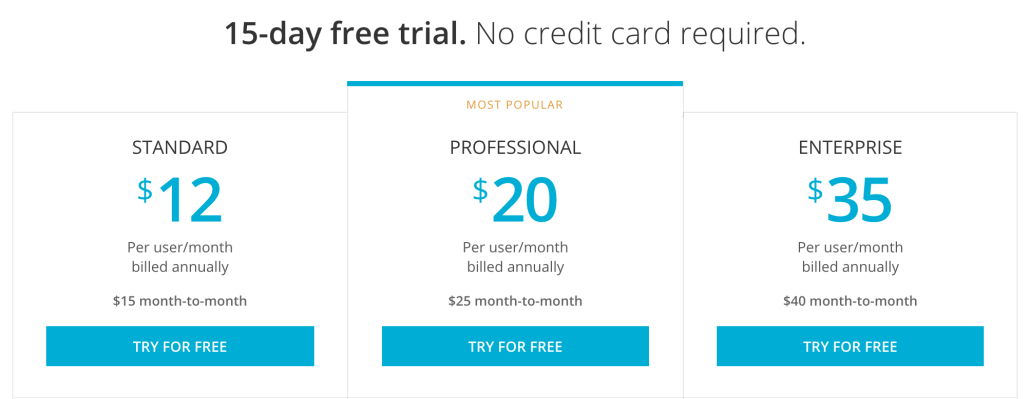
After much testing, they probably found the 15-day free trial mark to be the sweet spot for a couple reasons. One, it requires customers to commit to a paid plan sooner. Two, a shorter free trial probably pushes customers to try out the major features sooner than later, which reveals the value of the product to them sooner as well.
Try decreasing the length of your free trial and see how it affects conversions. If it doesn’t help convert more, then revert back.
3. Raise Your Prices
You’ve probably thought long and hard about your SaaS app’s price point. You probably looked at your closest competitors and wanted to be priced comparatively. Depending on your SaaS app, your price may be a major selling point.
However, most companies over think their price and base it only by their competitors. I’d like to challenge you and think about your price vs. the value your customers receive in return, because the price of your SaaS should be based on the value.
If you were able to raise your prices just 10% or 15%, how would that change your business?
Before you go and raise your prices today, you need to think of a careful strategy to do so. Some SaaS companies raised their prices that resulted in very negative effects. When Ahrefs, an SEO tool, increased their prices, it was met with a lot of negative feedback. Their mistake was increasing the price for existing customers and increasing the price way too much at one time.
Close.io, a CRM SaaS app, is a great example of a company increasing their price the right way. They didn’t raise the price for existing customers and they gave trial and paid customers a 14-day window to to buy more plans at the original price.
The results?
They kept current customers happy, they maintained their conversion rate after the price increase, and they received a nice bump in paying customers before the increase went live. Most importantly, they said the price change increased their LTV by 10%.
4. Improve Your Pricing Page
I’m willing to bet your pricing page is one of the most viewed pages on your website.
From your pricing page, prospective customers should be able to identify what they get, for what cost, and sign up as quick and easy as possible.
For this reason, your pricing page has a huge impact on your customer acquisition. That’s why it’s important to always be actively monitoring and improving the conversion rate of your pricing page. While your pricing page layout and design is going to be heavily influenced by your type of product, it must be simple, easy to understand, and help prospective customers choose the right plan for them.
Beyond the design of the page, your pricing model also has a huge impact on the conversion rate of your pricing page. It’s important you’ve developed your pricing model well, but that’s a whole other topic.
So what’s a good pricing page? I’ll use a few examples.
Freshbooks
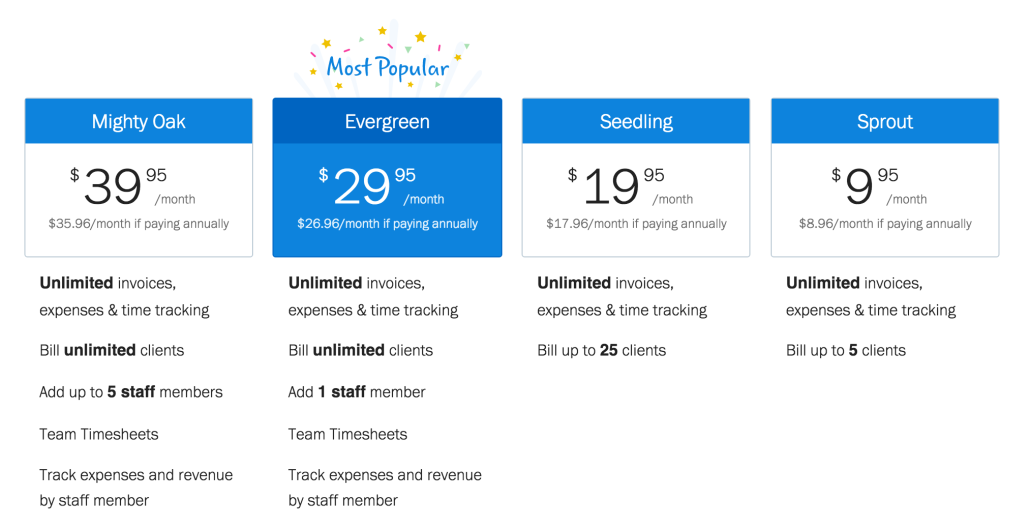
Freshbooks pricing page is designed very well and easy to understand. Prospective customers can quickly understand what features they’ll get and for what price. Interestingly, they don’t have “sign up” or “start free trial” buttons underneath each plan – they only have a single start free trial option. This not only helps keep their design simple but also prevents the customer from stalling from analysis paralysis.
Immediately, you’ll notice their most popular plan is the Evergreen plan because of the illustrated “Most Popular” graphic above it and the blue background on the price when the others are white. Telling people which plan is most popular always helps prevent analysis paralysis.
Beyond the pricing plan section, their pricing page can be divided into six unique sections.
- Call-to-action #1 – “Sign me up! I already know I want Freshbooks.”
- Pricing plans – “Okay, what do I get and for how much? Do you have a plan for me?”
- More details and call-to-action #2 – “Looks good so far, but what else do I get?”
- Testimonial and Trust – “Someone like me is happy with the product and this is a company with high praise.”
- FAQs – “But what about… Oh, okay. That answers my question!”
- More trust and call-to-action #3 – “Millions of people use Freshbooks? I’m ready. Sign me up.”
Note that each section one way or another helps the prospective customer make their decision and sign up.
BuzzStream
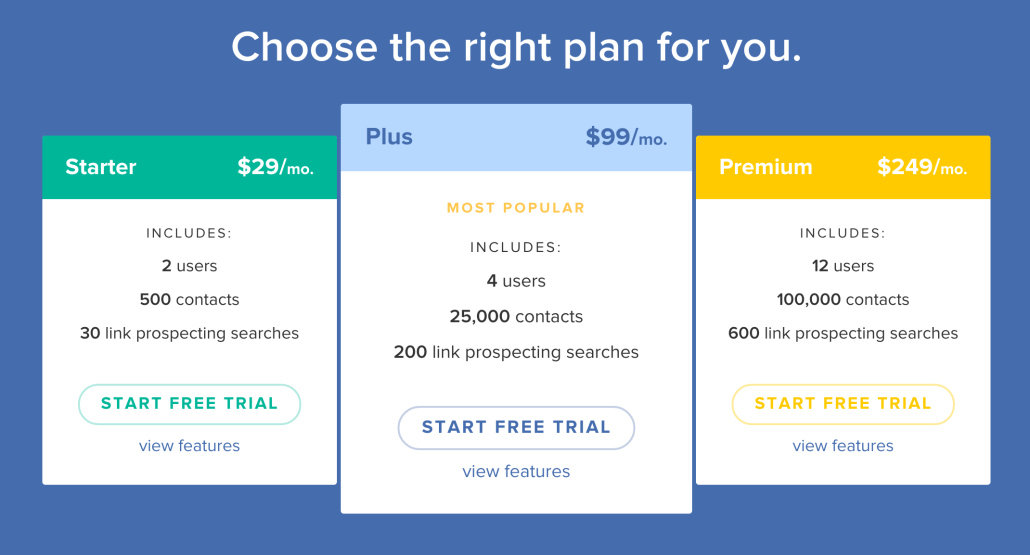
Let’s look at BuzzStream’s pricing page. They are a social influencer and digital outreach app.
Just like Freshbooks, their pricing plans are very easy to understand with their main plan differentiators front and center: number of users, number of contacts, and number of searches. By only including the main features that differentiate each plan, BuzzStream’s pricing plans are quickly and easily digestible.
BuzzStream’s pricing page can be broken down into three sections:
- Pricing plans
- FAQs
- Pricing package details
Simple and to the point, BuzzStream’s pricing page is to the point; however, there is room for improvement. There are no sections on trust – testimonials, social proof, etc. You have to email them to pay them for 12 months in advance. And most interestingly, they only feature their solo package in the pricing package detail section, which can either turn those customers away by being too hidden, or tricking people to sign up for a more expensive plan than they need to.
Help Scout
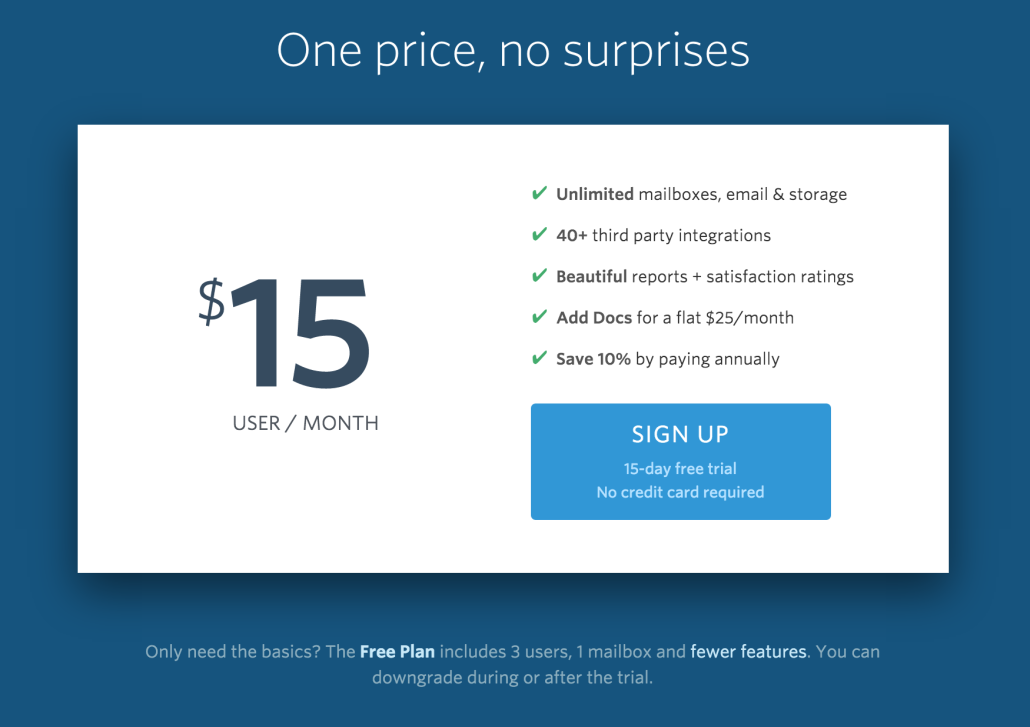
Help Scout has one of the most simple pricing pages I’ve ever seen.
Their pricing model, besides their free plan, is just $15 per user per month. In just one single “pricing box” they show their prospective customers everything they get with a big “sign up” button. This makes it incredibly brainless for prospective customers to sign up.
Their pricing page is broken down into four sections:
- Pricing plan
- FAQs
- Customer service/help – schedule a demo or contact for further questions
- Additional features
In addition to the single pricing plan, I love their customer service/help section. Featuring four people’s faces brings a feeling of humanity and great customer service into their product – except it doesn’t say who they are (employees, happy customers, etc). Including the ability to schedule a demo or view a webinar recording is a nice customer service touch as well.
Again, adding powerful testimonials can help increase trust and conversions on their pricing page.
When looking at your SaaS app’s pricing page, see how you can incorporate elements from these examples. If you’re not familiar with analysis paralysis, price anchoring, trust, and other psychological pricing strategies, read up on them and see how you can incorporate them to improve conversions.
Offer an Annual Payment Option
Give discounts to customers who’d like to pay for 12 months up front to get an immediate surge in cash flow. Typically, this discount is either one month of free service or a 10% discount.
There’s two reasons why this is a great strategy:
- You keep customers for at least 12 months
- You increase your cash to invest in further growth
Tomasz Tunguz illustrates the dramatic difference in a SaaS company’s cash depending on how it’s paid. Each scenario depicts a different way it collects cash, but in each scenario they make the same revenue, have the same growth, and have the same amount of burn.
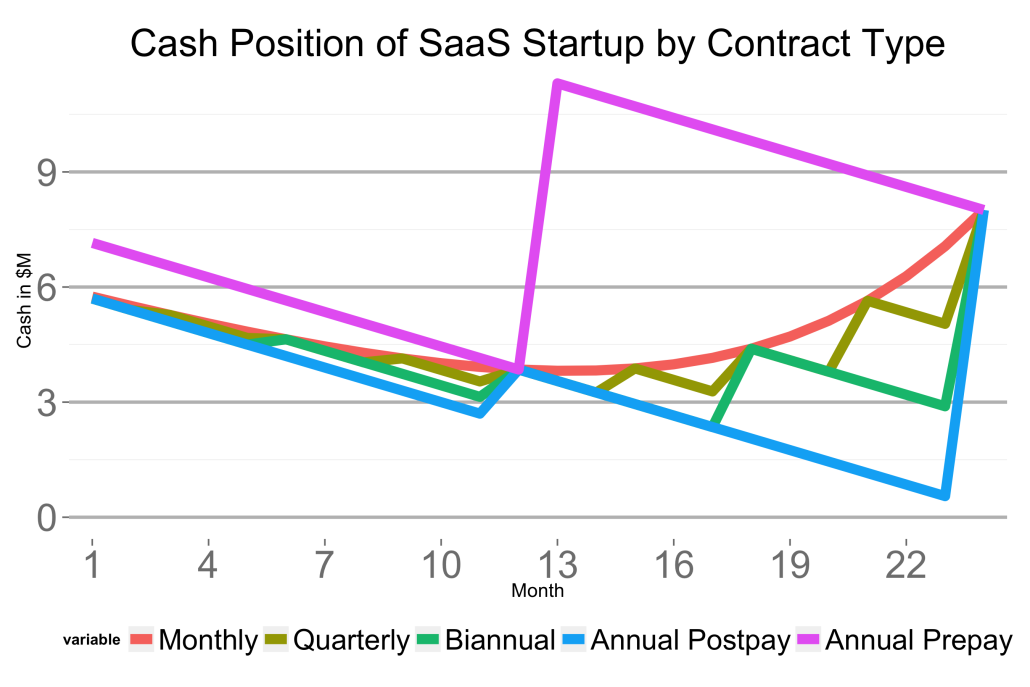
Source: Tomasz Tunguz
Notice in purple the annual prepay is the best scenario in terms of cash. Accepting 12 month payments up front will boost your immediate cash to invest in other growth strategies, like building a growth team for example.
What to Do Next
Now you know a few ways to gain more of your prospective customers’ trust, help them purchase a paid plan, improve your customer retention, and increase your cash flow.
To recap, they are:
- Adding powerful testimonials to your website and pricing page
- Decreasing the length of your free trial
- Raising your prices to reflect your product’s true value
- Improve and simplify your pricing page
- Accept annual payments up front
Implement these strategies correctly and you will see an increase in your bottom line. If you’re already doing these and would like to implement a more aggressive growth strategy, set up a confidential discussion with Stimulead and see what we can do for your B2B SaaS company.

